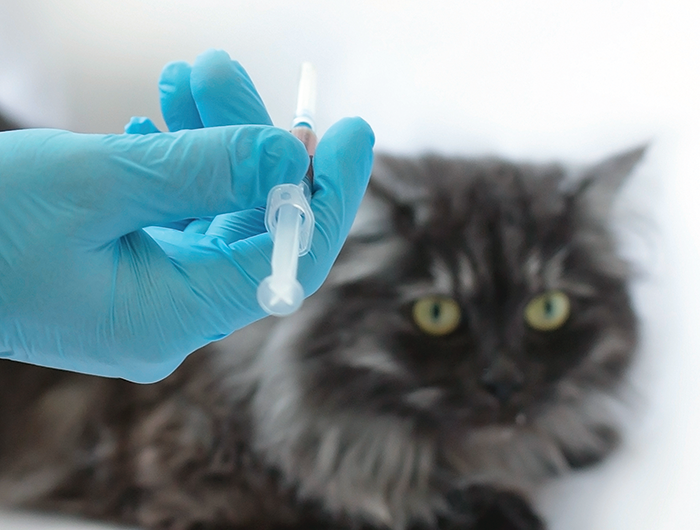When we think about chemotherapy, the first thing that often comes to mind is the side effects that people suffer. Chemo for pets is different. First, the goal is usually not a complete cure that can last for decades. Instead, the veterinary goal is prolonged remission, hopefully giving your pet close to a normal lifespan with good quality of life. Accordingly, treatments are not usually as aggressive.
Chemotherapy destroys cancer cells, which rapidly divide, by disrupting cell division. Unfortunately, some normal cells that also divide rapidly, such as bone-marrow cells, also can be affected. This side effect is why your cat needs periodic bloodwork. Side effects can also hit the gastrointestinal tract, with signs ranging from mild nausea and inappetence to diarrhea and vomiting.
“Cats handle chemo better than dogs, so they typically experience fewer side effects. 80% of pets have no side effects. In the 15% to 20% that do have side effects, they are typically not severe,” says veterinary oncologist Susan Ettinger, DVM DACVIM (Cornell, ’98). For cats, nausea is the most common problem owners see.
Dealing With Nausea
Mirtazapine (Remeron), a human anti-depressant, is often used as an anti-nausea drug for cats. The drug helps to control vomiting and acts as an appetite stimulant, making it a great two-in-one medication for cats on chemo. It has traditionally been given as an oral pill.
Mirtazapine transdermal ointment (Mirataz) is an FDA-approved form of the same drug that is applied to the ear as a transdermal ointment. Because it eliminates the difficult job of getting your cat to consume a pill, this may be your veterinarian’s first choice.
Cats that are nauseous and not eating should be offered frequent small meals. Smelly foods like tuna are your best first bet, and lightly warming the meals may also encourage eating.
Rarely, cats receiving chemotherapy may experience diarrhea. If this is the case, consider putting your cat on a bland diet. Don’t worry about a balanced meal for a day or two as you work to get her gastrointestinal tract back to normal. Boiled chicken breast or hamburger can be enticing.
Precautions for Home Chemotherapy Treatments
If you are giving your cat chemotherapy medications at home, you need to take some precautions. If you are pregnant, breast feeding, or immunocompromised, it is preferable that someone else administers the treatments and handles the drugs.
The person giving the drugs should wear tight-fitting latex gloves so he or she won’t drop pills and won’t have direct contact with the drugs. Wash your hands thoroughly after treating your cat and throw away the gloves. Medications must be dispensed as they are to be given. Avoid breaking up pills.
Store medications in their original containers. If a pet, child, or other household member mistakenly gets into them, notify your veterinarian, family physician, or a poison-control center immediately. Keep medications away from food, ideally in a safe spot with a lock.
Whether chemotherapy drugs are given intravenously or orally, metabolites (waste products from the metabolism of the drugs) will often be excreted in the urine and/or stool. Wear gloves to clean your litterbox and clean the box at least once a day. Keep other pets away from the litterbox. This must usually be done for 72 hours post treatment, but check with your veterinarian to be sure. Dispose of the waste as directed by your veterinarian. Dr. Ettinger recommends washing any soiled bedding separately and for two complete cycles before you reuse it.
Other Side Effects
Fever is a sign that your cat may be having problems post-chemotherapy. While many of us prefer to use ear thermometers, rectal thermometers give the most accurate results. Digital thermometers are especially fast and accurate. If your cat has a fever (temperature over 103°F), Dr. Ettinger says to contact your veterinarian.
If you see bloody urine, call your veterinarian. Bloody or frequent urination could mean a bladder infection secondary to your cat’s lowered immune system due to the chemo.
Your cat may become dehydrated secondary to fever or nausea. You can encourage water consumption by adding flavoring to your cat’s water. Juice from tuna packed in water is one popular choice. Some cats will drink more if left a slowly dripping faucet or from a pet fountain. In some cases, cats may need subcutaneous fluids, which you can learn to give at home.
Direct Medication Effects
If you suspect a medication may be causing side effects, contact your veterinarian before making any changes.
Your cat may receive her chemo medications as intravenous injections at the veterinary clinic. When she comes home, watch the injection site for any swelling, redness, or pain. Some chemotherapy drugs can be given orally and may be dispensed for you to give at home. If your cat is notoriously difficult to pill, ask about compounding options that might make it easier. Sometimes a liquid flavored oral version can be made up for your cat.
Cancer Research
Veterinary oncologists know that many tumors do not respond well to chemotherapy, but they can’t identify which before treatment. The Cornell Feline Health Center is funding research by Kelly R. Hume, DVM, DACVIM, asssociate professor of oncology at the Cornell University College of Veterinary Medicine, into the use of metasurface-enhanced infrared reflection spectroscopy (MEIRS) to detect salinomycin-induced membrane changes in feline cancer cells. Salinomycin is a drug that has anti-tumor properties and improves the effectiveness of doxorubicin, a common chemotherapy drug. If MEIRS can detect structural and functional changes in the cancerous cell membranes, it may help determine if doxorubicin is likely to be effective prior to its use.




